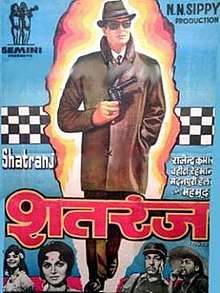Shatranj (1969 film)
| Shatranj | |
|---|---|
 Poster | |
| Directed by | S. S. Vasan |
| Produced by |
S. S. Vasan N. N. Sippy |
| Starring |
Rajendra Kumar Waheeda Rehman |
| Music by | Shankar Jaikishan |
Production company | |
Release date |
|
| Country | India |
| Language | Hindi |
Shatranj (lit. Chess) is a 1969 Indian Hindi-language spy thriller film co-produced and directed by S. S. Vasan. His final directorial venture, it stars Rajendra Kumar, Waheeda Rehman, Mehmood, Shashikala, Helen, Achala Sachdev and Agha.
Plot
Sharda has been married to Thakur for several years, and both have a daughter: Meena. Sharda and Meena suddenly decide to leave India and settle down in a communist country, without letting Thakur know. Concerned about them, Thakur hires Jai, a spy, to locate them, and bring them back if possible. Jai agrees and soon arrives in that country, which is ruled by a military general who has not shown his face to anyone. Jai assumes the identity of Shinraaz, goes around trying to locate the two women, and finds Meena, who works as a dancer in a hotel. Jai eventually learns what brought Meena and her mother to this country, and why they both are not willing to return to India.
Cast
Adapted from Bollywood Hungama:[1]
- Waheeda Rehman as Meena Thakur
- Achala Sachdev as Sharda
- Helen as Salma
- Rajendra Kumar as Jai
- Madan Puri as Comrade Chang
- Shashikala as Suzie
- Agha as Comrade Lee Jung
- Mehmood as Amir
- Manmohan Krishna as Thakur (uncredited)
- Rajan Haksar as General Khohny (uncredited)
Production
Shatranj was the final film directed by S. S. Vasan.[2] He co-produced the film with N. N. Sippy under Gemini Studios.[3][4] Madan Puri's character was modelled after the fictional character Fu Manchu.[5] The film was colourised using Eastmancolor.[6]
Soundtrack
The music was composed by the duo Shankar Jaikishan.[3][7] Hasrat Jaipuri, S. H. Bihari, Indeevar and Kiran Kalyani were the lyricists.[4]
| Tracklist | |||
|---|---|---|---|
| No. | Title | Singer(s) | Length |
| 1. | "Na Socha Na Samjha Na Seekha" | Asha Bhosle | |
| 2. | "Aao Tumhen Pyar Karna Seekha Doon" | Mohammed Rafi | |
| 3. | "Badli Mein Chhupe Chand Ne" | Lata Mangeshkar, Hemant Kumar | |
| 4. | "Shatranj Ki Chaal Hai Hamari" | Mohammed Rafi | |
| 5. | "Jungle Mein Mor Nacha Kisne Dekha" | Lata Mangeshkar | |
| 6. | "Samjho Zara Kahti Hai Kya" | Mohammed Rafi, Asha Bhosle | |
| 7. | "Badkamma Ekad Boto Ra" | Mohammed Rafi, Sharda Rajan Iyengar | |
| 8. | "Ajnabee Hoon Main Is Jahan Mein" | Lata Mangeshkar | |
| 9. | "Tumhen Agar Main Apna Saathi" | Mohammed Rafi, Asha Bhosle | |
Release and reception
Shatranj was an "anti-China movie", and theatres screening the film in West Bengal were burnt down by Communist revolutionaries.[8] It was later forcibly removed from exhibition by the Government of that state.[9] In Bathinda, Naxalites tried to blow up the theatre where the film was being screened, but the police successfully removed the bomb before it could do any damage.[8] In a review dated 29 March 1969, the magazine Thought wrote, "Watching a game of shatranj, one needs some intelligence and common sense to follow the opponents' moves and countermoves. Watching Shatranj, the film, one has to suspend both intellect and [judgement]."[10] The film was commercially successful but, according to Vasan's son Balan, "not to the extent expected by the maker".[11]
References
- ↑ "Shatranj Cast & Crew". Bollywood Hungama. Archived from the original on 25 July 2017. Retrieved 25 July 2017.
- ↑ Bali, Karan (26 August 2015). "SS Vasan". Upperstall.com. Archived from the original on 2 November 2016. Retrieved 26 July 2017.
- 1 2 Pinto, Jerry (2006). Helen: The Life and Times of an H-Bomb. India: Penguin Books. p. 242. ISBN 978-0-14-303124-6.
- 1 2 Zaveri, Hanif (2005). Mehmood, a Man of Many Moods. Popular Prakashan. p. 183. ISBN 81-7991-213-2.
- ↑ Kini, Nandan (2 May 2015). "Gabbar is back but here is a must watch guide to the best of Bollywood's worst villains". Firstpost. Archived from the original on 25 July 2017. Retrieved 25 July 2017.
- ↑ "Shatranj". The Indian Express. Madras. 17 October 1969. p. 5.
- ↑ "Shatranj by Shankar-Jaikishan". Saavn. Archived from the original on 25 July 2017. Retrieved 25 July 2017.
- 1 2 Judge, Paramjit S. (1992). Insurrection to Agitation: The Naxalite Movement in Punjab. Popular Prakashan. p. 111. ISBN 81 7154 527 0.
- ↑ Mahmood, Hameeduddin (1974). The kaleidoscope of Indian cinema. Affiliated East-West Press. p. 152.
- ↑ "Banner on Ground Level". Thought: 19. 29 March 1969.
- ↑ Ghosh, Avijit (18 March 2012). "Gun-ho in Bollywood". The Times of India. Archived from the original on 25 July 2017. Retrieved 25 July 2017.